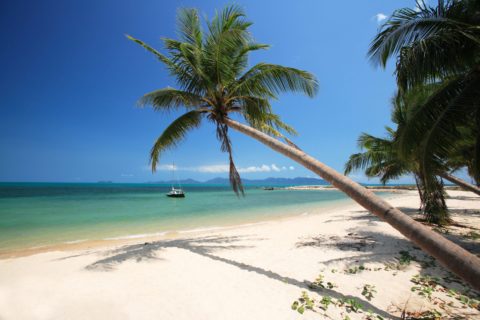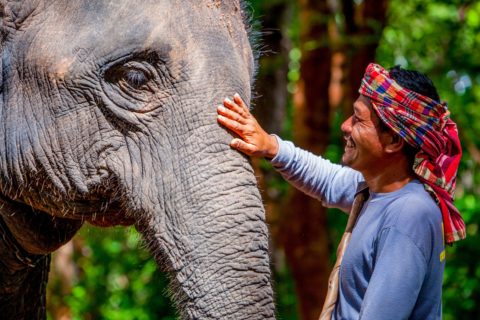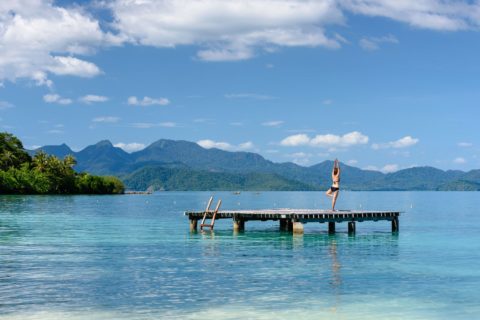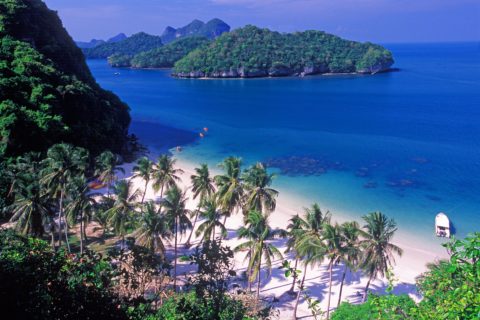One Writer Experienced All of Thailand’s Offerings, From a 5-Star Resort to Glamping. Here Are Her Top 5
No matter what direction you travel in, Thailand has plenty to offer a visitor
Not many people have heard of Koh Suwan, and there’s no reason they should have. It’s a slip of an island, an islet really, shaped like a bra. Bright green and lacy with palms, slightly lopsided, one cup more padded than the other.
I’d been staring at it from my deck chair at the Emerald Cove Resort in Koh Chang, Thailand’s second largest island after Phuket. Located across a placid stretch of turquoise water, Koh Suwan kept calling me with a melody as playful as the splash of white-frilled waves on sand.

A mere speck compared to Koh Chang, it didn’t seem to get much larger as I kayaked toward it. Nonetheless the journey fuelled my fantasy of finding the next perfect spot, the next deserted island or isolated mountain retreat that, once you discover it, seems to make Thailand uniquely your own.
The quest to find the next unsung destination in Thailand has long been a tourist cliché. You only have to read Alex Garland’s The Beach to get a sense of the passion that propels travellers to keep moving, as if Thailand, with its glittering temples, shirt-soaking heat, soft beaches and incense-lit shrines is a series of doorways always leading you onwards toward a place where you can plant yourself in a hammock and stay forever, or at least, once you have returned home, to adopt a look of smug superiority as you say, “But everyone does Phuket. Have you been to Koh Mak, Koh Bulon Lae or Pai?”
I’m no more immune to Thailand’s beckoning fingers than any other traveller, and that’s why I’d come to Koh Chang. Located on the eastern seaboard up near Cambodia, Koh Chang, or Elephant Island, is part of the Mu Koh Chang National Marine Park and the main stop in an archipelago of 52 islands.
With its paved coastal road and beachfront resorts Koh Chang is no stranger to development, but its mountainous interior is dense and unspoiled, a tangle of rainforest trees and waterfalls, home to barking deer, small Indian civets and stump-tailed macaques.
As I paddled up to Koh Suwan, its tiny beach sandwiched between mangrove trees, I saw another couple was already there. They’d set up a romantic picnic and had clearly hoped to be alone.
“I’m sorry I’m here,” I said, “but I didn’t expect you either.”
They laughed and we made an unspoken pact to ignore each other. I found a trail between the island’s two humps and crossed to the far shore. The ocean was wilder here. Waves splashed up onto slabs of rock and I stared out, already scanning the horizon for my next stop – Koh Kood perhaps, where I’d heard the beaches were shaped like moon slivers. Instead I travelled to Thailand’s far north, to the notorious Golden Triangle.
Escape North
For some, Thailand’s beaches are its siren call, for others it’s the remote jungle, and there is no place as far-flung and infused with mystique as the Golden Triangle, at the confluence of the Ruak and Mekong Rivers where Laos, Myanmar and Thailand meet.
Once a dark hub of the opium trade, the Golden Triangle’s lush hills still conjure visions of opium dens, clandestine drug deals and CIA spies – though times have changed and these days the fascinating Hall of Opium in the Golden Triangle Park is the closest the average tourist will get to a poppy field.
The tourist centre of Sop Ruak is a popular destination for day-trippers, with tourists shuttling in from the northern cities of Chiang Rai or Chiang Mai to take a boat ride between countries and maybe stop at the Laos island of Don Sao to buy souvenirs.
They’re missing out, I thought, sipping a G&T at the Burma Bar at the Four Seasons Tented Camp Golden Triangle as the sun set over the Ruak River and the hills of Myanmar faded into shadow.
To call the Four Seasons Tented Camp an all-inclusive jungle experience does not do it justice. From the moment I glided in on a sleek longtail boat, I had the sense of being transported to a different world – a world more reminiscent of elegant 19th-century expeditions than of any hotdog-and-bonfire campsite of my childhood.

There are rescued elephants to feed sugar cane snacks to, a spa in a bamboo forest and a free-form pool. Yet the camp has only 15 tents, most stretched out along the hillside like sentry posts. Each tent – and I use the word lightly – has reclaimed teak floors, a hand-hammered copper tub and private deck with rain shower – plus Wifi and air conditioning, of course – and I had to keep poking the canvas walls to convince myself I was camping.
Escape South
Eventually the thought of sun and sand lured me back to Thailand’s beaches, but here I had a dilemma. Did I go to Koh Samet, the nearest resort island to Bangkok, where I had fond memories of beach hopping barefoot down the length of the island, stopping for fresh grilled crab and cold Singha beer?
Or did I revisit Railay Beach in Krabi Province, where limestone cliffs plunge into the aquamarine Andaman Sea, a sight so breathtaking it’s the visual equivalent of a bungee jump?
In the end I went further south to Koh Phangan, the Ibiza of Asia. A short ferry ride away from larger Koh Samui on Thailand’s east coast, Phangan’s claim to fame is the vibrant Full Moon Parties held monthly on the beach at Haad Rin. There was no full moon when I visited, but Haad Rin was still lively, the youthful crowd so sun-polished and leggy it looked like a bumped-up movie version of what Thailand beach life should be.
Away from Haad Rin the pace slows and travellers can find everything from meditation centres to 5-star resorts. After whiling a few days away on the quiet west side, I ended up where I always end up, on the island of Koh Samui.

No one, anywhere, could call Koh Samui undiscovered. Many mourn the loss of six-dollar-a-night bungalows and jet-ski free beaches. What I celebrate is Koh Samui’s parallel side. Away from the bars and the bakeries and bustle of Chaweng Beach is the island’s holistic core. A number of spas, retreats and detox resorts are dotted around the island and one of the best is Kamalaya.

Situated on Koh Samui’s southern coast, Kamalaya drifts up a hill with a beach at the bottom and ancient granite boulders rising out of the foliage. There is a centuries-old monk’s cave, lotus ponds, yoga pavilions, a lap pool and deluxe spa facilities with programs ranging from Optimal Fitness to stress-relieving Asian Bliss.
Kamalaya has a unique earthy energy, and after a Vital Essence Oil Massage I padded to the outdoor Jacuzzi, sitting in solitary contentment amidst coconut palms and fluttering birds. I’ve stopped looking onward, I realized. The quest to find Thailand’s next ‘It’ destination is addictive – and with so many hidden corners it can be a lifelong event – but sometimes it’s just nice to sit back and touch ground.
Where to stay:
The 5-star Emerald Cove Resort is located on quiet Klong Prao Beach in Koh Chang.
The Four Seasons Tented Camp Golden Triangle is a luxury tented camp where you can interact with elephants, spa, trek and enjoy the serenity.
Kamalaya Wellness Sanctuary and Holistic Spa Resort on Koh Samui offers wellness programs, holistic medicine, spa and healing therapies.
Searching for a luxurious hideaway in Bangkok? The sumptuous Shangri-La Hotel, Bangkok on the banks of the Chao Phraya River offers a tranquil retreat from the hustle of the city with silk and teak finishings, riverside pools and its world-famous CHI, The Spa.
For more information on Thailand visit the Tourist Authority of Thailand.









